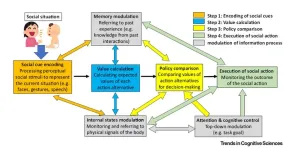Changing one’s behavior in different social interactions is child's play
Researchers propose a new cognitive framework explaining how infants modulate their behavior as per the social context.
2023-03-20
(Press-News.org)
Society and social interaction play a key role in life for humans. The well-being of a person greatly depends upon their ability to be part of complex socio-cultural institutions. Even during infancy, humans rely on their social interactions with other humans for social and cultural learning, subsequent adaptation to different social environments, and ultimately, survival. Several studies have shown that infants do not respond automatically or reflexively to external cues, but instead adaptively modulate their social behaviors to suit their social context. Gaze-following is one such behavior that infants modulate based on their surroundings. However, a few studies have shown that infants’ gaze-following can occur independently of their social context.
Consequently, the empirical evidence explaining contextual modulation of infants’ social behavior is inconsistent. Therefore, there is a need for a theoretical framework that can effectively describe the mechanism underlying such behavioral modulations. To this end, a new study by Dr. Mitsuhiko Ishikawa—a JSPS Research Fellow at Doshisha University’s Centre for Baby Science—uses contextual modulation of gaze-following behavior as a model system to evaluate how infants contextually modulate their communicative behavior. The study was published in Trends in Cognitive Sciences. This paper was made available online on 5th January 2023 and was published in Volume 27 Issue 3 of the journal in March 2023.
“We proposed that, from infancy, humans integrate perceptual information, memories and current physiological state to determine the optimal behavior in any social context through a value-driven decision-making process,” explains Dr. Ishikawa. This means that infants choose between different actions under every social context by assessing which action will result in the most rewarding outcome, such as acquiring new information or a social incentive. Dr. Ishikawa, along with Prof. Atsushi Senju from the Research Centre for Child Mental Development, Hamamatsu University School of Medicine, also proposed that external cues do not directly determine infants’ social behavior. To support these hypotheses, both researchers built upon their existing empirical research to design the ‘action value calculator model’, which describes the cognitive processes involved in how infants decide to behave during different social interactions.
This model suggests that infants first encode social cues in each context. These can include any kind of social stimuli, including faces, gestures, and speech. Then the infants process these social stimuli to form a representation of the current social situation. Thereafter, their brains calculate and compare the values of different alternative actions within a particular social situation. Once these action values are compared, infants finally choose to perform the optimal action that has the highest action value, that is, one that will result in the most suitable response/outcome in that social situation. The entire process of action value calculation and comparison can also be influenced by memory of past experiences and internal states, such as physical or psychological signals of the body. Moreover, these action values can be updated based on the feedback received upon performing that action. Since social situations are often dynamic and can include interactions, this process becomes iterative. Thus, once an action is performed, the social context is updated and processed from the start in order to perform another action.
But how do infants learn how to assign values to their actions based on their social situation? According to the researchers infants are predisposed since birth to engage with social stimuli. Then, with experience, they learn the likely combinations of actions and their outcomes to determine which actions work optimally under which social context. Additionally, individual differences in social experiences, such as familial environment, can further shape how infants assign action values. For example, deaf infants raised by deaf parents exhibit more gaze-following behavior than hearing infants raised by hearing parents.
Essentially, this value-based model highlights the significance of the internal value calculation and decision-making process in infants and supports studies that suggest that infants contextually modulate their social behaviors instead of following external cues. Envisioning how this research can be expanded further, Dr. Ishikawa says, “Our cognitive model could inspire empirical research of infants’ social behavior, including social actions other than gaze-following, from the perspective of value-based decision-making. This could also be linked to mechanisms that shape individual and cultural differences in social behavior, and perhaps improve our understanding of the fundamental question of how humans interact socially in their daily lives.”
About Dr. Mitsuhiko Ishikawa from Doshisha University, Japan
Dr. Mitsuhiko Ishikawa is a JSPS Post-doctoral Research Fellow at the Centre for Baby Science, Doshisha University, Japan and is also an Associate Research Fellow, at Birkbeck, University of London. He completed his PhD. in Experimental Psychology from Kyoto University in March 2021. He has also received the JSPS Ikushi Prize (2021) and the Kyoto University President’s Award (2020), among other laurels. Dr. Ishikawa’s main research interests lie in understanding how humans engage in social interactions. He is particularly interested in how humans perceive their social partner’s gaze information and respond to it.
Funding information
Mitsuhiko Ishikawa was supported by JSPS Research Fellowship (PD) Grant Number 21J00466, and Atsushi Senju was supported by JSPS KAKENHI Grant Number 22512422.
Media contact:
Organization for Research Initiatives & Development
Doshisha University
Kyotanabe, Kyoto 610-0394, JAPAN
E-mail:jt-ura@mail.doshisha.ac.jp
END
[Attachments] See images for this press release:

ELSE PRESS RELEASES FROM THIS DATE:
2023-03-20
New research indicates that a small percentage of financial landlords, like private equity firms and institutional investors, own four times more of Montreal’s rental housing stock than was previously estimated. Neighbourhoods with more financial landlords are also experiencing higher housing stress levels.
In the first comprehensive analysis of its kind in a North American city, researchers from the University of Waterloo and McGill University developed a new method of identifying networks of property ownership lurking behind ...
2023-03-19
**Note: the release below is a special early release from the European Congress of Clinical Microbiology & Infectious Diseases (ECCMID 2023, Copenhagen, 15-18 April). Please credit the conference if you use this story**
Embargo: 2301H UK time Saturday 18 March
Healthy dogs and cats could be passing on multidrug-resistant organisms (MDROs; bacteria that resist treatment with more than one antibiotic) to their hospitalised owners, and likewise humans could be transmitting these dangerous microbes to their pets, according to new research being presented ...
2023-03-18
Alexandria, VA – A symposium aiming to provide a better understanding of the tumor microenvironment, immune tolerogenic niches at cancer initiation, and novel immunotherapeutic strategies in head and neck cancer patients was featured at the 52nd Annual Meeting & Exhibition of the AADOCR, held in conjunction with the 47th Annual Meeting of the CADR. The AADOCR/CADR Annual Meeting & Exhibition took place at the Oregon Convention Center in Portland on March 15-18, 2023.
Cancer ...
2023-03-18
Alexandria, VA – In alignment with AADOCR’s Diversity and Inclusion Statement, several symposia exploring the ongoing challenges in addressing the oral health care needs of equity-deserving populations were featured at the 52nd Annual Meeting & Exhibition of the AADOCR, held in conjunction with the 47th Annual Meeting of the CADR. The AADOCR/CADR Annual Meeting & Exhibition took place at the Oregon Convention Center in Portland on March 15-18, 2023.
The symposium, “Assessing Oral Health ...
2023-03-18
Alexandria, VA – A study exploring the development of “Dental Tough Adhesive (DenTAI)”, a novel bioinspired adhesive patch with robust mechanical properties, capable of strong adhesion, and able to carry out extended release of clobetasol-17-propionate, the first-line drug for treating oral lichen planus (OLP) and recurrent aphthous stomatitis (RAS) was presented at the 52nd Annual Meeting & Exhibition of the AADOCR, held in conjunction with the 47th Annual ...
2023-03-18
Alexandria, VA – A symposium exploring the significance, interactions, and evolutionary mechanisms of salivary mucins was featured at the 52nd Annual Meeting & Exhibition of the AADOCR, held in conjunction with the 47th Annual Meeting of the CADR. The AADOCR/CADR Annual Meeting & Exhibition took place at the Oregon Convention Center in Portland on March 15-18, 2023.
Mucin proteins in saliva are responsible for the unique physicochemical properties of saliva that include lubrication, viscosity, and barrier function. A dense array of O-glycans attached to the mucin protein backbone provide mucins with their typical functions.
Recently, ...
2023-03-18
A study in the Journal of The National Cancer Institute Cancer Spectrum looked at chatbots and artificial intelligence (AI), as they become popular resources for cancer information. They found these resources give accurate information when asked about common cancer myths and misconceptions. In the first study of its kind, Skyler Johnson, MD, physician-scientist at Huntsman Cancer Institute and assistant professor in the department of radiation oncology at the University of Utah (the U), evaluated the reliability and accuracy of ChatGPT’s ...
2023-03-18
University of Utah Health scientists have corrected abnormal heart rhythms in mice by restoring healthy levels of a protein that heart cells need to establish connections with one another. That protein, GJA1-20k, is underproduced in people with a genetic condition called arrhythmogenic cardiomyopathy, one of the leading causes of sudden cardiac arrest in athletes under the age of 35.
The finding, reported in the journal Circulation Research, suggests a new strategy for treating the abnormal heart rhythms caused by arrhythmogenic cardiomyopathy.
The results may also have implications for treating dangerous arrhythmias associated with more common ...
2023-03-18
Recently incarcerated people with opioid use disorder have trust in working with peer support specialists who recovered from addiction and faced similar life experiences, according to a Rutgers study.
The study, published in the journal Psychiatric Services, found that peer support specialists were most valued for providing emotional and community-based addiction recovery support as well as housing and employment information — crucial when going back into the community.
More than ...
2023-03-18
House hunting on Mars could soon become a thing, and researchers at the University of Arizona are already in the business of scouting real estate that future astronauts could use as habitats. Researchers in the UArizona College of Engineering have developed technology that would allow a flock of robots to explore subsurface environments on other worlds.
"Lava tubes and caves would make perfect habitats for astronauts because you don't have to build a structure; you are shielded from harmful cosmic radiation, so all you need to do is ...
LAST 30 PRESS RELEASES:
[Press-News.org] Changing one’s behavior in different social interactions is child's play
Researchers propose a new cognitive framework explaining how infants modulate their behavior as per the social context.


